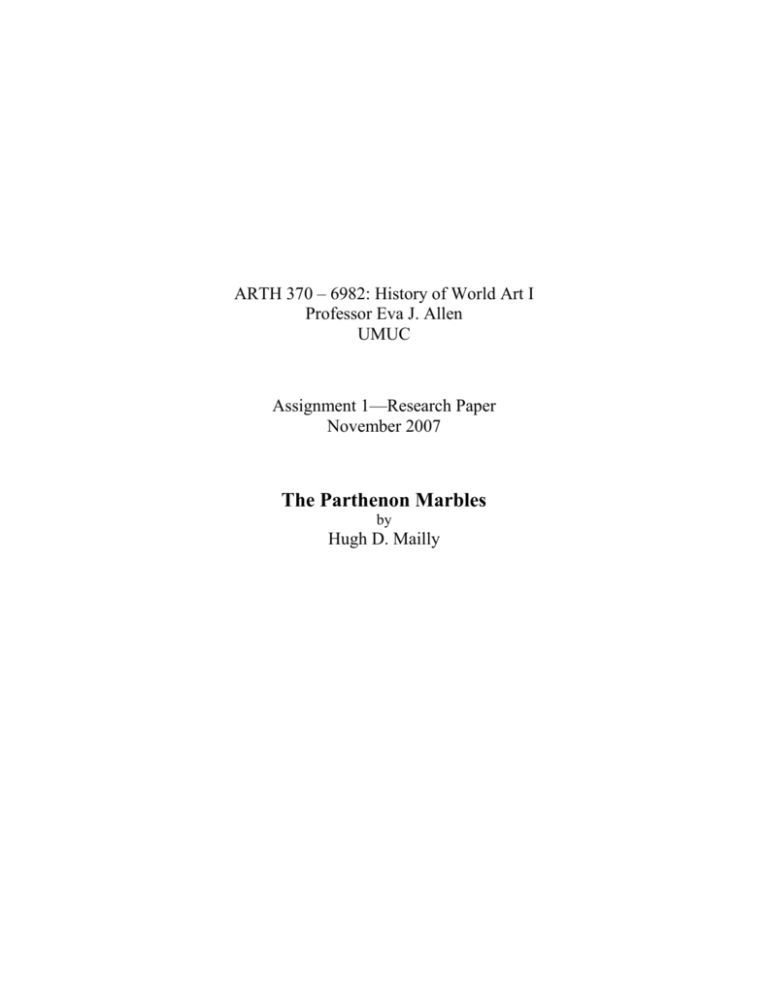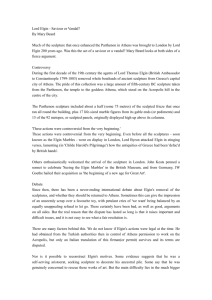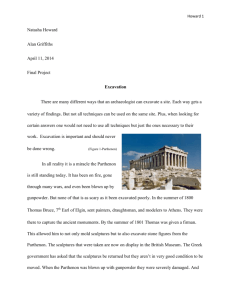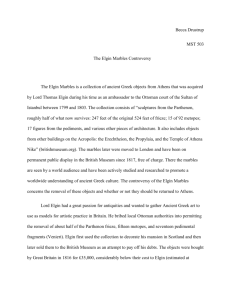
ARTH 370 – 6982: History of World Art I
Professor Eva J. Allen
UMUC
Assignment 1—Research Paper
November 2007
The Parthenon Marbles
by
Hugh D. Mailly
The Parthenon Marbles
The slab of marbled wall shows ten serious men holding back spirited horses. Each represents a
phylarch, the cavalry commander of the ten original tribes or phylai of Attika, Greece. In their
original residence at the Parthenon of Athens, they guarded the rear of two civic processions to
the statue of the goddess Athena.1
Description: A fragment, part of the north frieze from the Parthenon
on the Acropolis, Athens, showing horsemen in the Panathenaic
procession, marble, h. 1.07 m, c. 437–c. 432 BC.
Photo credit: British Museum, London, Scala/Art Resource, NY.
Grove Art Online. Oxford University Press, 2005. 3 Nov. 2007
http://www.groveart.com.ezproxy.umuc.edu/shared/components/util/
popup_image.html?imagesourceid=F016169&authstatuscode=200
Western civilization has deep historical roots in ancient Greece. The extensive polis of Athens
was the cradle for our present way of life, and the Parthenon in the Acropolis overlooking
Athens played an important part in that early cultural nurturing. The Parthenon was in fact the
visible soul of the society that led to much of whatever degree of enlightenment our "western"
democratic nations can pride themselves with today. Like prehistoric cave dwellers who painted
highly meaningful figments of their imagination onto Neolithic cave walls, between 447 and 438
BCE, architects and sculptors of the Greek High Classical Era2 carved their own beliefs into the
Parthenon building.3 They imbued their temple with an idealized mixture of mythology and
reality. Gleaming white marble was one of the primary materials utilized to construct the
Parthenon; artists also used it to form the loose artifacts housed within. Much of the artwork was
a part of the construction itself, not separate from it. They achieved harmony between sculpture
and architecture.4 The marbles, both fixed and loose, became a noiseless yet compelling outcry
from the heart of a culture centered around a religion with many dynamic gods. The marbles
spoke volumes of what ancient Greece was all about, and the Panathenaic procession in honor of
the goddess Athena was a highly expressive element of their artistic composition. Over two
thousand years after they were made, an Englishman removed many of the marbled works from
the Parthenon and took them to England. Eventually, the topic of an international controversy
regarding the marbles narrowed to whether they should be returned to Athens or should they
remain in British museums. There are many arguments for and against repatriation; however,
from a purely emotional point of view, it seems conscionable that the marbles belong where they
were born, in a rejuvenated Parthenon of Athens.
When ancient Greeks settled in fixed areas to grow food instead of chasing it, they built forts on
high ground for protection against marauders and for worshipping their gods. These citadels
expanded downhill into cities and outwards to include large tracts of cultivated land. The whole
became city-states or polis. In a place that they named Athens after a particularly important
goddess, the old fortified high point became the Acropolis...the top of the town. There, the
Athenians erected buildings of magnificent gleaming white marble.5 They applied a structural
approach involving tall columns that bulge slightly in the middle (entasis) on top of an already
extensive vertical aspect, and created a sense of reaching for the heavens.6 On the sacred rock7
that was the Acropolis, the Greeks built the Parthenon to replace an older, smaller temple to
Athena that the Persians had destroyed.
Description: Photograph of the Acropolis, Athens, Greece.
Photo credit: "Acropolis" Online Photograph. Encyclopaedia
Britannica Online. 6 Nov. 2007
http://www.search.eb.com.ezproxy.umuc.edu/eb/art-84910/TheAcropolis-Athens
Temples were an important Greek architectural form8 because religion and mythology were
inseparable from the daily life of ancient Greeks.9 Inside the Parthenon, they built a naos or
cella, a kind of Greek version of holy tabernacle, to house Athena Parthenos (the virgin,
according to Mattusch) in a figurative form. She was colossal and made out of chryselephantine,
that is, gold and ivory.10 Part of the veneration of the goddess involved a ritual parade at least
every four years involving everyone in Athens.11 Athena, as well as a few other things, was the
protector of Athens.12
Description:
Photo credit:
"Database of exhibited works of art" Louvre. 6 Nov. 2007
http://cartelen.louvre.fr/cartelen/visite?srv=car_not_frame&idNotice=809
In addition to the multitude of horsemen, the Panthenaic festival procession depicted in the
Parthenon contained many more sculptures. It started in southwest corner of the naos, split into
two parades, then reunited in front of Athena as well as other deities.13 Another example of the
procession, portrayed on a different frieze, was that of the Maidens leading the procession:
Description: Maidens leading Panathenaic Procession by Phidias
(c.500-432 BCE). Marble section from the Ionic continuous frieze,
which extended around the upper exterior walls of the cella of the
Parthenon.
Photo credit: IN101. Elgin Marble Room, British Museum, London,
England. The room contains original sculpture from the Parthenon
brought to England, c.1800CE. Photographed by Dr. Robert Prestiano
(c). Online photo. 3 Nov 07
http://www.angelo.edu/faculty/rprestia/1301/images/IN100maids.jpg
The main medium used to build and sculpt the Parthenon was Pentelic marble from nearby
Mount Pentelikon.14 Probably the most important property of marble that the sculptors
considered, as far as its use in statuaries was concerned, was its ability to transmit light by
reflecting minute penetrations of it.15 Because of the medium's importance in the resulting works
of art, both the architecture and the detached works went down the annals of history as "the
Parthenon Marbles." The original composition of the marbled works adorning the Parthenon
consisted of:16
Over five hundred feet of 40-inch wide Ionic frieze, part of the structure of the
Parthenon itself, carved in situ.
Ninety-two Doric metopes, also part of the structure but individual sculptures in
high relief.
Various pediments or unattached sculptured statues.
The low-relief Ionic frieze ran atop the cella wall, and contained 115 brightly painted panels
displaying both figures and animals.17 These displayed the Panathenaic festival procession that
included the cavalry. It is considered "characterized by superb rhythmic design and faultless
execution...a perfect expression of Greek sculpture of the mid-5th century BC."18 The theme of
the high-relief metopes of the external Doric frieze depicted various mythical triumphs of
civilization over barbarism, which happened to be the Athenian viewpoint regarding their
victories against the Persians.19 Various strange beings were represented, such as the battle
between the Lapiths and the Centaurs.
Description: Battle between Lapiths and Centaurs.
Photo credit: Photos of the Parthenon Marbles by Ian Swindale.
Online photo. 6 Nov 2007
http://www.uk.digiserve.com/mentor/marbles/IMG0089b.jpg
The pediment of a building was the triangular space enclosed by the gables at either end of the
building, and it was often adorned with sculptures.20 With the Parthenon, above the metopes sat
the highly crafted marbled pediments, full figures illustrating the birth of Athena and her
competition with the god of the sea Poseidon.21 The classical order of temple construction was
usually either an older, simpler Doric or a newer and more refined Ionic. The difference was
mainly in the construction of the columns. For the Parthenon, while the interior friezes were in
the Ionic order, the exterior was in the Doric order style. This made the Parthenon a uniquely
constructed building, different from the norm.22
The British Empire appointed Thomas Bruce, seventh Earl of Elgin, known as Lord Elgin (17661841) of Scotland, ambassador to the Ottoman Empire in 1799. Elgin had married Mary Nisbet a
few years earlier, and he had given his wife, a very young member of British high society, a new
mansion that possibly only needed more fine works of art to complete its opulence. The
Ottomans ruled Greece at the time, and Elgin found his way to Athens in 1801. Mary came with
him, and according to Susan Nagel, author of The Mistress of the Elgin Marbles, she was to be
"the life force behind the project" or removing the Parthenon marbles. Mary apparently was the
wealthy half of the Elgin marriage, and she paid for all of the work involved in the quasiarcheological work Elgin undertook at the Parthenon.23 In any case, it seems that many English
artists were interested in obtaining castings of the Parthenon sculptures, and that was the initial
impetus for Elgin's arriving on scene at the Acropolis of Athens. Apparently, the Elgins found
the Parthenon to be in ruins, and local people were hacking off pieces of sculpture wantonly.
Elgin then apparently felt he would be doing humanity a favor by saving what had not already
been destroyed.24 It should be noted that the Ottomans were Muslim and Islamic tradition forbids
"graven images"; therefore, the Parthenon sculptures were not perceived as valuable to their
owners at the time.25
Description: Thomas Bruce, seventh Earl of Elgin, Lord Elgin (1766-1841). Also,
eleventh of Kincardine, and the Ambassador Extraordinary and Minister
Plenipotentiary of His Britannic Majesty to the Sublime Porte of Selim III, Sultan of
Turkey in Constantinople.26
Photo credit:
Carte de Visite Photograph c. 1865. Photographed by Mathew Brady.
Online image.
http://www.picturehistory.com/product/id/15410
Elgin's team began by making drawings, then removing and crating most of the best items for
shipping to England.27 By the time the Greek Civil War put an end to their work, they had
"rescued" many marbled works, including seventeen pediment statues and dozens of slabs of
Parthenon frieze. Many inscriptions plus reliefs from the cella walls, metopes,28 and even loose
vases were also added to the booty.29 This represented about half of the existing salvageable
works of art attached to or in the Parthenon. Hall tallies the list as follows: 247 feet of frieze out
of an original 524 feet, 15 metopes out of an original 92, and 17 pediments.30 They also
excavated other buildings, including the Erechthenum and the Temple of Athena Nike. They
removed an entire corner of the first, plus one of its Caryatids (female figures supporting
entablatures) and at least four slabs of the latter.31 What they could not take they made wax casts
of.
Most anectodal accounts of how Elgin and his work crew removed the marbles, especially those
that were part of the Parthenon building itself, all seem to point at barbarian-type plunder more
than careful archeological activity. The English poet Byron in particular made Elgin seem like a
dour exploiter. One of Byron's poems, "Childe Harold's Pilgrimmage", includes the line " And
snatch'd thy shrinking Gods to northern climes abhorr'd", which effectively says it all for those
who would think of Elgin as a looter of antiquities, as opposed to a savior of them, as others
propose. However, if it was plunder, it was plunder with a permit, similar to the old custom of
governments giving privateers letters of permission to act like pirates during times of war. With
his wife's money, Elgin apparently bribed all of the right Turkish officials.32 It also helped that
the youthful Lady Elgin, his wife, greatly endeared herself in many ways to the sultan and even
with the sultan's mother, the Valida Sultana, who happened to be the titled owner of the
Acropolis.33 The Sultan gave Elgin a series of firman letters of authority that allowed him and
his agents to "study, draw, mould, excavate and even carry off various antiquities. The actual
methods applied to removing the marble were however definitely not up to the standards
expected of modern archeological digs, and this would later feed the fires of the controversy
surrounding the Parthenon marbles. The workers actually smashed some marbles while
retrieving others. They also cut a lot of grand pieces into smaller portions for easier
transportation. In 2007, in a similar dig say in Egypt, those two defective actions alone would
probably land an archeologist in jail.34
Between 1801 and 1817, British warships took the Parthenon marbles to England, where the
collection became known as The Elgin Marbles. As a side story with important consequences,
the French captured Elgin and his wife while they were traveling back to England in 1803. When
Elgin finally got "home" three years later, his marriage and his finances were utterly destroyed.
Because Mary had all the money, Elgin's divorce resulted in his having to dispose of his
unaffordable luxuries, including the marbles, which by then were stored in a condition hardly
better than the ruined Parthenon from which they had been removed.35 Still, it took some ten
further years after Elgin's return before the British museum agreed to buy the marbles for a cheap
price, and begin earnestly restoring and displaying them, mostly in the Duveen Gallery. In the
1930s, they were transferred to a specially designed neoclassical gallery. Rooms 18, 18a and 18b
of the British Museum were designed to reflect the Parthenon, utilizing both original pieces and
some plaster cast copies.36
Description:
Elgin Marble Room, British Museum, London, England.
Photo credit:
Photographs by Dr. Robert Prestiano (c).
Angelo State University, Texas.
Classical Greek Art, c. 450 - 410 BCE
November 4, 2007
http://www.angelo.edu/faculty/rprestia/1301/list_of_illustrations2.htm
http://www.angelo.edu/faculty/rprestia/1301/images/IN101ElginRm.jpg
In the 1980s, reacting to activism by the Greek actress Melina Mercouri, the modern independent
government of Greece took serious notice of the fact that half of the Parthenon Marbles were
Elgin Marbles in an English museum. A wave of Greek patriotism rose to insist that all of the
marbled works should be reunited in Athens, in a new museum to be built near the ruins of the
original Parthenon. Archeologists and even much of the British public also began to support the
notion. The British parliament was urged to order repatriation of the marbles. Those interested in
keeping the artwork in England pointed out that Greece had no place to put them and that is how
construction of a new museum in Athens got started.37 Poets, artists, cultural leaders, politicians,
diplomats, lawyers, and academics38 have lined up on both sides of the controversy, which from
time to time flared up into near-violent argument. The high cost of maintaining the marbles, let
alone moving them has always been a major issue. One suggestion made by the British Museum
is that the Marbles could become the subject of a lease between England and Greece that would
acknowledge the latter as rightful owners but place the financial burden on England and permit
Greece to "borrow" the marbles for display in Athens.39 This idea however, would involve the
marbles spending a lot more time in England, and it did not generate much enthusiasm.
The main British position in the argument over where the marbles belong can be summarized
into three major points as follows.40
1. Safety: The sculptures are safer in the British Museum than they were or would ever be, in
Athens.
2. Accessibility: The marbles can be viewed free by millions of visitors to the internationally
famous British Museum.
3. Legality: Elgin was not a looter; he was a savior of archeological artifacts who had permission
to take the marbles.
Expert opinions presented in favor of the British position include the following three academic
theses. Dr. Dorothy King, a leading archeologist and author of The Elgin Marbles, who studied
classics at King's College, London and did her PhD on Greek architectural sculpture, posited that
Greee has a "poor record of caring for its treasures." Therefore, the marbles will be safer for
posterity, in a multicultural world, if they remain in the care of the British Museum.41 James
Hall, author of The World as Sculpture, presented a strong case for leaving the Marbles where
they are on the basis of their influence on the world of art. He pointed out that in the British
Museum they are in "ideal" viewing conditions in a "world city", which would not be the case in
less visited Athens. He also postulated that as the Elgin Marbles, they "stimulated the production
of high-quality art in the 19th century"; he also claimed the marbles are still catalysts for modern
artistic ideas.42 William St Clair, a senior research fellow at Cambridge43 and author of Lord
Elgin and the Marbles, published by Oxford University, emphasized the legal aspects of the
argument and claimed that Elgin did obtain a firman from the Sultan and although the original
was lost, a copy made at the time, survived.44
The Greek anti-thesis not only disputes the British points, it adds a few new arguments. The
Greek rebuttals are:
1. Safety: Greece is prepared to protect and preserve the marbles.45
2. Accessibility: A new museum at the foot of the Acropolis can house all of the marbles and
experts can maintain them just as well as they have been in England.
3. Legality: Professor David Rudenstine of the Benjamin N. Cardozo School of Law, who
evidently researched Elgin's legal position thoroughly, postulated in the International Journal of
Cultural Property that Elgin's asserted right to take the marbles "may well be false."46 One
question that has received attention is whether the Ottomans had the right to give or sell Greek
property.
The Greek government's essential position, apart from defeating the British claims, is not legal,
but moral-based. The Greeks admit that replacing the marbles on the decrepit Parthenon itself is
no longer a practical consideration. However, they feel that all of the Parthenon sculptures
should be gatherered from around the world and reunited in Athens, to bring what is Greek back
to Greece, if for no other reason. They offer a kind of mystical reasoning, in that the reunification
of all of the fragments of the Friezes depicting the grand Procession is necessary for the
Parthenon monument to be properly understood. The Greek governmnent has tried, mostly
unsucessfully, to convince detractors that at issue is not only a matter of Greek nationalism but
also of world cultural heritage.
Beginning in 1975, Greece began transferring carvings from the Parthenon to the Acropolis
Museum47 that will soon be known as the "old museum", because a totally new museum has
been built, beneath the Acropolis. Originally, the new museum's opening was to coincide with
the 2004 Olympics; however, this was delayed. Finally, in mid-October 2007, the Greek
Government began moving its own half of the Parthenon Marbles into the new museum. The
work is scheduled for completion by the end of November 2007 and space has been calculated
into the dimensions of the new building to house the Elgin Marbles collection if the British ever
let it go.48 The New Acropolis Museum designed by Bernard Tschumi contains the following
features relevant to the Parthenon Marbles:
1. There is a glass structure where all of the reunited Parthenon and Elgin Marbles can be
exhibited. This gallery will be called the Parthenon Hall.
2. The marbles will be displayed in Parthenon Hall as they were on the Parthenon itself.
3. The actual Parthenon will be visible to visitors from the gallery, by looking through the glass
roof.49
Description:
The New Acropolis Museum, Athens, Greece
(Scheduled to open to the public in November 2007)
Photo credit:
"Marbles"
Digiserve dot com
Online image. 4 Nov. 2007
http://www.uk.digiserve.com/mentor/marbles/
If or when all of the Parthenon marbles are re-assembled in the New Acropolis Museum, they
will still be missing huge parts. Approximately 15-20 percent of the Ionic Frieze disintegrated
over the years at the Parthenon itself.50 The surviving frieze is presently spread between England,
Greece, and eight other international museums. There is even one panel of frieze in the Louvre. 51
Keeping the marble clean to avoid color discoloration is evidently difficult. Destructive methods
have been erroneously applied and most of the friezes are now a tan, honey color, probably
mostly due to exposure to air. Other accidental damage has occurred at the British Museum,
including schoolboys knocking over statues, and at the Parthenon in Greece where an earthquake
occurred in 1981, damaging the east facade.
In terms of the important ramifications of the Parthenon vs. Elgin marbles controversy for the art
community, probably the most crucial point to consider is how the marbles, whatever they are
called, and wherever they are situated, have stimulated creativity in artists. It is a fact that the
marbles were a part of "academic artistic training" up to the era of "early modernism." Some of
the biggest names in the world of art made plaster casts of the marbles at the British Museum,
including Degas, Seurat, Rodin and Picasso.52 It is argumentative as to whether or not the
marbles would have continued to exist, let alone be available to artists if Lord Elgin had not
brought so many of them to London. Whatever history's verdict on that, artists can now rest easy
that even if the marbles are all reunited in Athens, they will be in an environment where artists
can continue studying them and finding inspiration from them. In fact, their relocation to the
source of their creation may be an added impetus to modern artists. I can see a fledging Rodin
circa of the third millennium staring up at the ruins of the Parthenon as he moulds a copy of the
ten phylai before him.
It seems that repatriation of all of the Parthenon marbles from around the world, especially the
large collection in the British Museum, back to Athens would be like mending a broken heart.
Although the Greeks must admit that their country did not care for the priceless treasures in their
own country for a long time, they are certainly very interested in doing so now. The reasons may
be political, popular, or mystical. It does not really matter why. Going back home is an essential
spiritual goal for all living things, and perhaps works of art that have so much influence on
human thinking have a kind of life of their own also that deserves respect. As Professor A.M.
Snodgrass of Cambridge University pointed out, the marbles were and are not simply detached
works of art, and the issue is "a bigger one than that of scholarship, and at the same time more
lasting than that of politics: it is one that lies at the heart of culture itself."53 The ten phylai failed
in their assignment to guard the procession from intruders. The procession was dissipated to
many a foreign place, not just England. It is time for them to be exonerated, for their charges to
be reunited in front of them so that they may continue their vigilance perhaps eternally hereon.
Notes
1
Browning.
Mattusch.
3
Athens.
4
Parthenon.
5
Athens.
6
Browning.
7
Parthenon Frieze.
8
Honour and Fleming.
9
Module 3.
10
Athens.
11
Greek Religions.
12
Athena.
13
Mattusch.
14
Browning.
15
Marble.
16
Hall.
17
Lapatin.
18
Frieze, Encyclopaedia Britannica.
19
Lapatin.
20
Hemingway.
21
Mattusch.
22
Module 3.
23
Interview. Susan Nagel, author of Mistress of the Elgin Marbles:A Biography of Mary Nisbet, Countess of Elgin.
24
Fehlmann.
25
Goldman.
26
George.
27
Lapatin.
28
Allen, Eva.
29
George.
30
Hall.
31
Fehlmann.
32
Hawthorne.
33
Interview.
34
Fehlmann.
35
Interview.
36
Hawthorne.
37
Browning. See also Hope.
38
George.
39
Hartford.
40
Hawthorne. See also George.
41
King.
42
Hall.
43
Hawthorne.
44
St. Clair.
45
George.
46
Rudenstine.
47
Lapatin.
48
Hope.
49
Browning.
50
Browning.
51
Lapatin.
52
Fehlmann.
53
Snodgrass.
2
Works Cited
Allen, Eva. ARTH 370 WebTycho class conferences. November 2007.
"Athena" Encyclopaedia Britannica. 2007. Encyclopaedia Britannica Online. 3 Nov. 2007
<http://www.search.eb.com.ezproxy.umuc.edu/eb/article-9010063>.
"Athens." Encyclopaedia Britannica. 2007. Encyclopaedia Britannica Online. 3 Nov. 2007
<http://www.search.eb.com.ezproxy.umuc.edu/eb/article-24803>.
Browning, Robert. Emeritus Professor of Classics of the University of London.
Cited by Professor Benita Goldman, Program Associate, Cultural History Tours.
Eastern Michigan University. 4 Nov 2007
<http://www.emich.edu/abroad/staff/Benita/Athens.html>.
Fehlmann, Marc."Casts & connoisseurs: the early reception of the Elgin Marbles"
Apollo 165.544 (June 2007): 44(8). Academic OneFile.
Gale. University of MD University College. 1 Nov. 2007
<http://find.galegroup.com.ezproxy.umuc.edu/itx/start.do?prodId=AONE>.
"Frieze" Encyclopaedia Britannica. 2007. Encyclopaedia Britannica Online. 3 Nov. 2007
<http://www.search.eb.com.ezproxy.umuc.edu/eb/article-9035441>.
George, Herman and Kaiser, Kate, Professor of Constitutional Law.
The Nation. May 29, 2000. 3 Nov 2007
<http://www.cardozo.yu.edu/life/summer2000/elgin/>.
Goldman, Benita. Athens. Eastern Michigan University 4 Nov 2007
http://www.emich.edu/abroad/staff/Benita/Athens.html
"Greek Religions. Encyclopaedia Britannica. 2007.
Encyclopaedia Brittanica Online. 5 Nov 2007
<http://www.search.eb.com.ezproxy.umuc.edu/eb/article-65479>.
Hall, James. "Chip off the old block." New Statesman 1996. 130.4520 (Jan 15, 2001): 43.
Academic OneFile. Gale. University of MD University College. 1 Nov. 2007
< http://find.galegroup.com.ezproxy.umuc.edu/itx/start.do?prodId=AONE>.
Harford, Tim. "Antiquities roadshow..."
The Financial Times (Sept 15, 2007): 13. Academic OneFile. Gale.
University of MD University College. 1 Nov. 2007
< http://find.galegroup.com.ezproxy.umuc.edu/itx/start.do?prodId=AONE >.
Hawthorne, Christopher. "Thawing the Frieze. Elgin Marbles.
(Brief Article)." Architecture 89.8 (August 2000): 41. Academic OneFile.
Gale. University of MD University College. 1 Nov. 2007
< http://find.galegroup.com.ezproxy.umuc.edu/itx/start.do?prodId=AONE >.
Hemingway, Colette. "Architecture in Ancient Greece."
Metropoloitan Museum of Art, New York: Timeline of Art History.
October 2003. 3 Nov. 2007
<http://www.metmuseum.org/toah/hd/grarc/hd_grarc.htm>.
Honour, Hugh, and John Fleming. The Visual Arts: A History. 7th ed. Upper Saddle River, N.J.:
Pearson Prentice Hall, 2005.
Hope, Kerin. "Elgin Marbles project in swing." The Financial Times (Oct 15, 2007): 6.
Academic OneFile. Gale. University of MD University College. 1 Nov. 2007
<http://find.galegroup.com.ezproxy.umuc.edu/itx/start.do?prodId=AONE>.
"Interview: Susan Nagel discusses her new biography of Mary Nisbet,
'The Mistress of the Elgin Marbles'.(8:00-9:00 PM)(Broadcast transcript)."
Weekend All Things Considered (Sept 5, 2004): NA.
Academic OneFile. Gale. University of MD University College. 1 Nov. 2007
<http://find.galegroup.com.ezproxy.umuc.edu/itx/start.do?prodId=AONE>.
Susan Nagel is the author of The Mistress of the Elgin Marbles.
King, Dorothy. "Elgin Marbles" CBC. 3 Nov 2007
<http://www.cbc.ca/arts/story/2006/01/26/elgin-marbles.html>.
Lapatin, Kenneth D.S. "Parthenon sculptures", Grove Art Online. 3 Nov 2007
<http://www.groveart.com.ezproxy.umuc.edu/shared/views/article.html?from=search&session_search_id=18779930
2&hitnum=11&section=art.993514>.
"Marble ." Encyclopædia Britannica. 2007. Encyclopædia Britannica Online. 3 Nov. 2007
<http://www.search.eb.com.ezproxy.umuc.edu/eb/print?articleId=50758&fullArticle=true&tocId=9050758>.
Mattusch, Carol C. "Greek Art: 5. Sculpture" Grove Art Online.
Oxford University Press, 2007. 3 Nov. 2007
<http://www.groveart.com.ezproxy.umuc.edu/shared/views/article.html?from=search&session_search_id=18779930
2&hitnum=9&section=art.991972.5>.
Module 3. ARTH 370 WebTycho class. November 2007.
"Parthenon". Encyclopaedia Britannica. 2007. Encyclopaedia Brittanica Online. 5 Nov 2007
<http://www.search.eb.com.ezproxy.umuc.edu/eb/article-9058586 >.
"Parthenon Frieze". EKT: National Documentation Centre, Ministry of Culture.
2003. 5 Nov. 2007
<http://www.ekt.gr/parthenonfrieze/introduction/temple.jsp>.
Rudenstine, David, 1999. The Legality of Elgin's Taking: A Review Essay of Four Books on the
Parthenon Marbles International Journal of Cultural Property.
Vol 8, No. 1, 1999, pp. 356-376.
Snodgrass, A.M. Professor, Cambridge University.
From an article published as Appendix B in the British Committee's submission to the House
of Commons Select Committee. 4 Nov 2007
<http://www.uk.digiserve.com/mentor/marbles/>.
St Clair, William.
Lord Elgin and the Marbles: The Controversial History of the Parthenon Sculptures.
Oxford University Press, USA; 3 edition (July 17, 1998).
William St. Clair is a senior research fellow at Cambridge.









